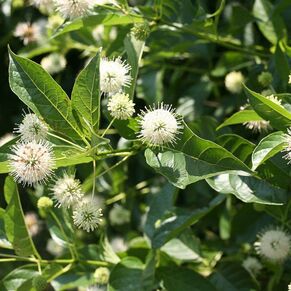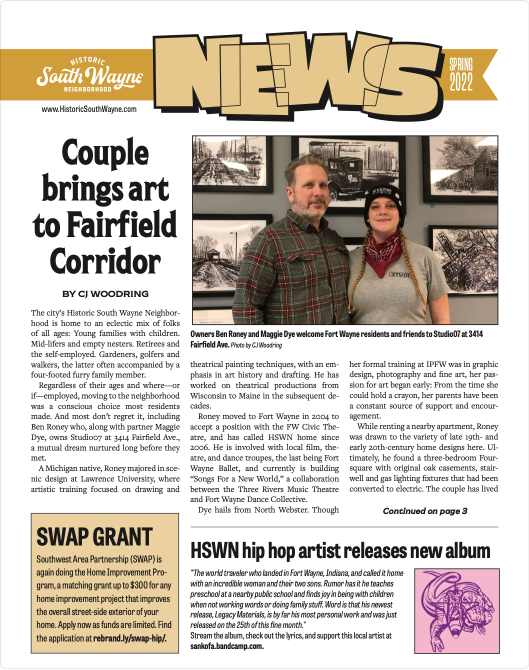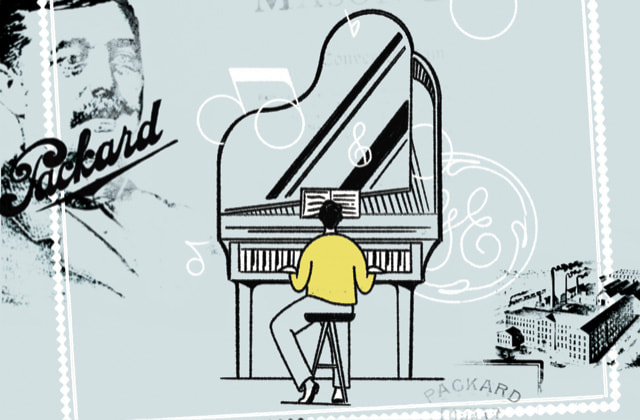 Buttonbush Buttonbush By Simon May With Spring right around the corner, many of our neighbors with a green thumb are excited to start planning their gardens for the fair weather seasons. An important part of landscaping is incorporating native plants to ensure that pollinators, birds, and “good bugs” are welcome in our area. Many people are familiar with the Indiana native purple cone flower, yellow black-eyed susan, and blue Siberian iris, but here are some not-as-well-known options that are easy to grow in the Indiana climate. Aromatic Aster: This showy, mounding perennial is a great option for dry areas of your landscape with rocky or sandy soil that drains well where you want to add a pop of late summer or early fall color that will keep the bees fed as the weather turns. After the summer blooms are spent, this blanket of rigid stems springs to life with pink to lavender-blue many-petaled flowers with an aromatic yellow center. Since the flowered stems can grow too tall (10-20”) and heavy for their own good, they may open up or fall into a less desirable shape, so a peony cage may be used or simply keep the mound thick by pruning it back by no more than half in June. This plant does spread by stolons or runner roots, so thin it regularly to control the size of the mound. Cardinal Flower: This perennial is for the hummingbird lovers as they are the primary pollinators of this plant along with butterflies. Cardinal Flower may be grown in full sun to shade, but moisture is a must as they cannot tolerate drought, so if planting in sun anticipate mulching and frequent watering. The showy red blooms that can rise 3-6’ tall are named after the bright red robes worn by Roman Catholic cardinals, not the state bird. This plant propagates by seed which can be collected at the end of the season for refrigeration, or the seed heads can be cut off to control spreading. Shooting Star: This distinctively flowering plant is among the likes of bleeding hearts or columbine in my book, something that looks strange and will make people ask “What is that?” The shooting star plant is a woodland species (part shade) that has been cultivated and become commercially available, benefitting bees and other pollinators. The leafless flower stalk arises 6-20” from a cluster of bright-green leaves. At the top, the stalk divides into arching branches, each terminating in a downward nodding flower with strongly-backward pointing white or deep pink petals forming star patterns in a cluster. Truly and unusually beautiful, these add a pop of early summer color to a shady area with moist rocky or sandy soil. Best propagated by division, similar to hostas. Common Buttonbush: This perennial shrub is a shade or part shade loving plant that can spread and grow up to 6-12 feet after several seasons, so give it some room. It can also be trained into a tree shape. Great for a wet area of your landscape that does not drain well, this shrub loves to have its feet wet and it’s leaves cool. The long-lasting, distinctive blossoms are usually white or pale pink with a fringe of pistils protruding out that resemble a pin cushion and attract butterflies, nectar bees, and birds in the fall who will eat the persisting nutlets within the blossom. Clematis Virginiana: This perennial climbing vine is very versatile as it can thrive in full sun to part shade on trellises or along fences. Most clematis are prized for their large flat flowers, but this clematis, also known as the Virgin’s Bower, produces small clusters of delicate white flowers that attract bees and other pollinators. This variety is also unusual because it blooms in the late summer or early fall. In the late fall, the flowers will transition to seed heads that look like beautiful swirling clouds. These are easily removed if you’re worried about spreading. It is important to purchase this plant from a greenhouse and not source it naturally since there are some invasive varieties. If you try any of these plants in your garden, please send pictures to the Historic South Wayne Neighborhood Association Facebook page for us to share. Happy gardening! Simon May has lived much of his life in the '07 and currently resides on Kinnaird with his husband, Richard, and their four dogs. He is a lifelong gardening hobbyist, by no means an expert, whose love of plants, flowers, and the outdoors was fostered by his master-gardener mother and his father who came from a family of farmers. By CJ Woodring Illustration by Ben Swygart Fort Wayne has carved a niche among Indiana cities since its 1794 establishment, acquiring designations including “Summit City,” “Magnet Wire Capital of the World,” “City of Churches,” and “The City That Saved Itself.” We’ve also been designated a “Tree City” and several times were cited as an “All-American City,” most recently in 2021. Thus, I was excited when I spotted a WANE-TV online article in January: Greater Fort Wayne, Inc., supported by Mayor Tom Henry and other city leaders, has joined forces in creating a 10-year economic development plan with goals that include recognition as a “Top 10 Music City” by the end of 2023. This will include “expanded festivals, music venues, training and education and music-industry innovation,” according to the article. While Fort Wayne’s current musicians and performers most often are acknowledged, little has been mentioned, thus far, of the music history that led us here. And which we’re partially recalling in several newsletters, noting both commercial endeavors and individual efforts and accomplishments. INITIAL CONTRIBUTIONS TO INDIANA’S MUSIC HISTORY Moreso than any other art form, music unites people. Thus, while acknowledging music is a universal language that conveys happiness and joy, it is also a globally recognized anchor when times are bad: global chaos and war, community violence, the Great Depression, pandemics such as COVID-19. In these shared times of collective misery and woe, music offers hope and, to many, a reason for living. Individuals have been known to spend their last dime on a form of music: Nourishing one’s soul is often more important than feeding one’s belly. No stranger to music in any form, or forum, the Hoosier State has been associated with music since at least the early 1900s, when Elkhart earned distinction as “Band Capital of the World.” Although instruments were produced in various Hoosier cities at the beginning of the nineteenth century, more than 60 manufacturers were at one time based in the City with a Heart. One of Fort Wayne’s first, and perhaps most notable, foray into music lauded an instrument: the Packard piano. Isaac Packard and associates relocated to Fort Wayne from Chicago following the 1871 Great Chicago Fire. They established the Fort Wayne Organ Company the following year. In 1899 the name officially was changed to The Packard Company and, in 1915, to The Packard Piano Company. Located on Fairfield Avenue, the company was a go-to for musicians in the market for parlor pianos as well as orchestral organs that graced venues including the Emboyd Theater. The company went into receivership after the 1929 stock market crash. In 1937, the city of Fort Wayne acquired the property, tore down the buildings and created Packard Park in its place. (See packardorgan.com.) In the interim, local General Electric employees, whose former campus currently is undergoing adaptive reuse as Electric Works, enjoyed making music, entertaining not only coworkers but city residents. According to author Clovis E. Linkous’ 1994 book, “General Electric at Fort Wayne, Indiana: A 110-Year History,” the Electro-Technic Club Band first entertained in February 1910 at an ETC roller skating party. The group later held Thursday noon luncheon concerts in McCulloch Park, formerly known as G.E. Park. In the spring of 1925, the Male Glee Club was organized, followed five years later by construction of a new bandstand in the park. A 25-member Male Chorus was introduced in 1935 and performed that fall for the Parent-Teachers Organization at Nebraska School. The last group of GE music makers was a 36-piece band organized in 1937. Linkous suggests that World War II “probably disrupted the musical organizations” at the Fort Wayne plant. More recently, in June 2009 the City renovated the 1930 bandstand on the four-acre green space, adding a musically-themed playground with fanciful instruments that make different sounds, allowing children to create their own music. The City’s Parks & Recreation Department, Broadway Corridor merchants, businesses, organizations and others celebrated the rededication during the first Broadway Family FunFest, which featured the Fort Wayne Area Community Band, formed about 40 years ago. Read Part II Here. CJ Woodring has been affiliated with the 46807 district since growing up on W. Oakdale Drive. She graduated from South Side High School and reared her sons on Kinnaird Avenue, where she served as a former HSWNA newsletter editor. She has lived in –– and loved — historic places and spaces for more than 30 years. She currently resides in her sixth historic home. |
Archives
May 2024
|



 RSS Feed
RSS Feed
